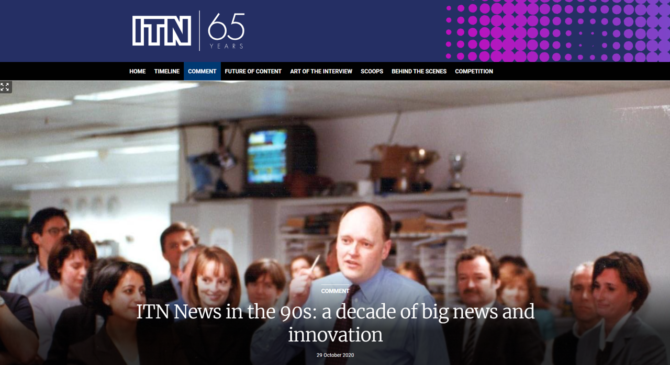
To mark the 65th Anniversary of ITN going on air, ITN and Broadcast magazine set up a special microsite in September 2020, which hosted what they called “a ten-week festival of news and content to provoke debate about the future of journalism and TV production”.
I was commissioned to write two articles for the site – one on ITV News in the ’90s, and one on how ITN covered the death of Princess Diana in 1997.
This is the first of the articles.
ITV News in the 90s: a decade of big news and innovation
There is always a danger of looking back and thinking that events that happened in the past were more interesting, more dramatic, more challenging than those in current times. Indeed, I once criticised a former ITN reporter for being a member of what I called the “better in my day brigade”.
Undeniably, the current ITV News team is dealing with some massive news stories, from Covid to Brexit, but I genuinely think that the 1990s was an extraordinary decade for television news – particularly for ITV News.
When I left ITN in 2002, I wrote an article for the Independent newspaper saying that over the nearly 10 years that I had been Deputy Editor and then Editor of ITV News I couldn’t remember “a quiet or settled time”, and that it had been “a roller-coaster of a period”.
There were, of course, some major news stories to cover during the 90s – the first Gulf War, the Dunblane massacre, the election of Tony Blair, the death of Princess Diana, and the war in Kosovo.
All of them involved breaking into the ITV schedules with news flashes and extended programming, and all of them benefitted from the ITN approach of sending top reporters and experienced camera teams, who mainly focused on producing high quality packages for the main news programmes.
The ITN way, since the 60s, had been to develop distinctive and high calibre on-screen reporters and correspondents, and in the 90s we continued this approach by setting out to build up a well-known, trusted and diverse ‘family’ of on-screen staff. This included established ITN reporters like Mark Austin, James Mates and Caroline Kerr, and new appointments like Andrea Catherwood, Shiulie Ghosh, and Tim Rogers.
As for newscasters, the decade was dominated by Trevor McDonald and John Suchet.
Trevor was appointed the solo presenter of News at Ten in 1992. Research we commissioned returned a consistent response that viewers both trusted and liked him. This combination of being authoritative and popular was a crucially important asset to ITN throughout the period.
John Suchet was also hugely popular, becoming the face of the Early Evening News for much of the 90s. His great skill was presenting live programmes, particularly breaking news, intuitively and professionally. He hosted ITN’s all-night coverage of the start of the Gulf War, in January 1991, for example, and was the main commentator on the ITV Princess Diana funeral programme in 1997.
We also had a great production and technical team back at Gray’s Inn Road – too many to mention by name, but including programme editors, writers, producers, directors, PAs, studio staff, video editors, graphics staff, and the technical and admin teams.
But what really marked the decade was that we seemed to have as much drama off-screen as on. In those days, any newspaper story involving ITN was photocopied and clipped into the daily cuttings, and delivered to our offices first thing in the morning. It was a rare day that the cuttings pile wasn’t at least half an inch thick as ITN, day after day, generated newspaper headlines.
Newscasters coming and going, claims that we were dumbing down or being too upmarket, battles with spin doctors, the latest on contract negotiations, the brand migration from ‘ITN News on ITV’ to ‘ITV News’ and, of course, the story that ran through a large part of the 90s – the move of News at Ten, which finally took place at the end of the decade in 1999.
But looking back, I would argue, we took it all in our stride. I have memories of days when the newsroom buzzed with energy as news events unfolded around us, and of the cheerful camaraderie that is so often a by-product of a large open plan newsroom.
And there was also, I believe, a lot of innovation and pushing technical and editorial boundaries. There was the increasing and more reliable use of mobile satellites to carry out live interviews, the move from analogue to digital in the studios, and the beginnings of the introduction of desktop editing towards the end of the decade.
We also experimented with the studio design– such as putting the new Gray’s Inn Road newsroom as the backdrop to the Early Evening News in the early 90s, and pioneering the use of virtual reality graphics in ITV news programme in the mid-90s.
And we actively encouraged ‘reporter involvement’, filming reporters asking questions, and getting more of a personal eye-witness style into the editing of packages.
So… I’m definitely not arguing that it was “better in my day”, but the 90s were certainly an interesting and eventful time to be a TV journalist!
In the 20 years since the 90s, so much has changed. The proliferation of TV channels, the internet, and smart mobile phones. It all means that TV news programmes, across the networks, have a much tougher job at punching through what is a highly fragmented media landscape.
But what hasn’t changed is what I would describe as the ITN formula: a combination of experienced reporters and crews, a strong production and technical team, high profile presenters, and distinctive programmes.
